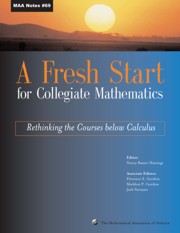Book contents
- Frontmatter
- Preface
- Contents
- Introduction
- Background
- Theme 1 New Visions for Introductory Collegiate Mathematics
- Theme 2 The Transition from High School to College
- Theme 3 The Needs of Other Disciplines
- Theme 4 Student Learning and Research
- Theme 5 Implementation
- Theme 6 Influencing the Mathematics Community
- Ideas and Projects that Work: Part 1
- Ideas and Projects that Work: Part 2
Theme 5 - Implementation
- Frontmatter
- Preface
- Contents
- Introduction
- Background
- Theme 1 New Visions for Introductory Collegiate Mathematics
- Theme 2 The Transition from High School to College
- Theme 3 The Needs of Other Disciplines
- Theme 4 Student Learning and Research
- Theme 5 Implementation
- Theme 6 Influencing the Mathematics Community
- Ideas and Projects that Work: Part 1
- Ideas and Projects that Work: Part 2
Summary
In the six papers in this section, we learn from the experience of others who have implemented changes at their institutions, who have developed new curricular materials and designed new courses, or who are utilizing emerging technologies. We also revisit the impact of education reform on the transition from high school to college and the appropriate placement of students. In particular, Robert Megginson offers some suggestions for successfully implementing a new curriculum from the faculty standpoint, while Judy Ackerman offers suggestions from an administrator's standpoint. In support of Zalman Usiskin's earlier claims about the importance of placement, Sheldon Gordon argues that implementing new pedagogies and new curricula necessitates rethinking the way students are placed into college courses. Lawrence Moore and David Smith discuss the impact of technology on the way students learn. Al Cuoco describes designing new instructional materials that are based on students' “habits of mind,” instead of being topic driven. Many participants at the conference, Rethinking the Preparation for Calculus, felt that the problem with college algebra and precalculus is that they are trying to serve too many audiences. Bonnie Gold describes how at her institution, they solved the one-course-does-not-fit-all situation by dividing their college algebra course into several different courses “each with a clear mission and a separate clientele.”
The University of Michigan at Ann Arbor initiated some major curricular revisions in its precalculus and introductory calculus courses in the early 1990s. … […]
- Type
- Chapter
- Information
- A Fresh Start for Collegiate MathematicsRethinking the Courses below Calculus, pp. 211 - 212Publisher: Mathematical Association of AmericaPrint publication year: 2006

